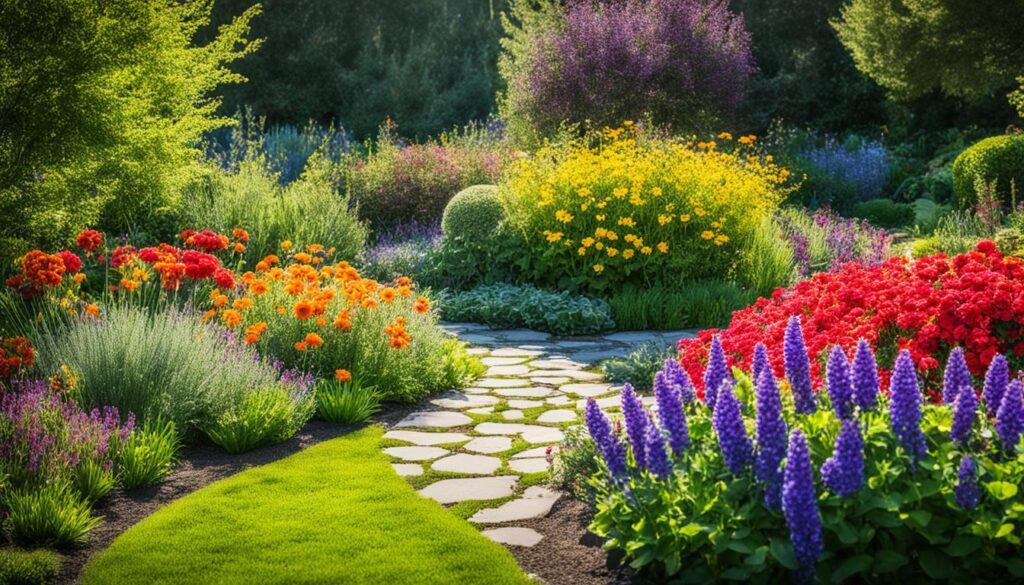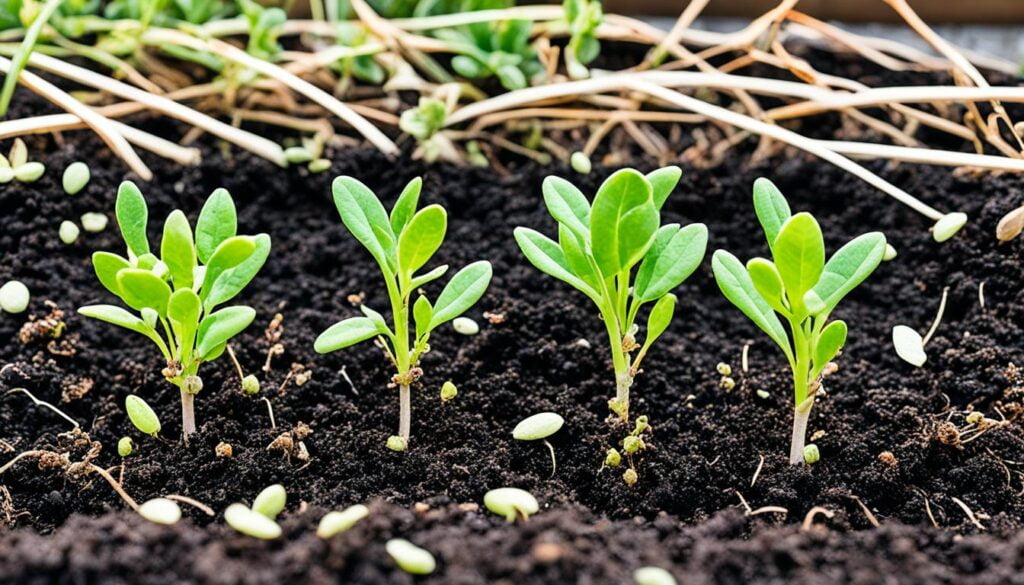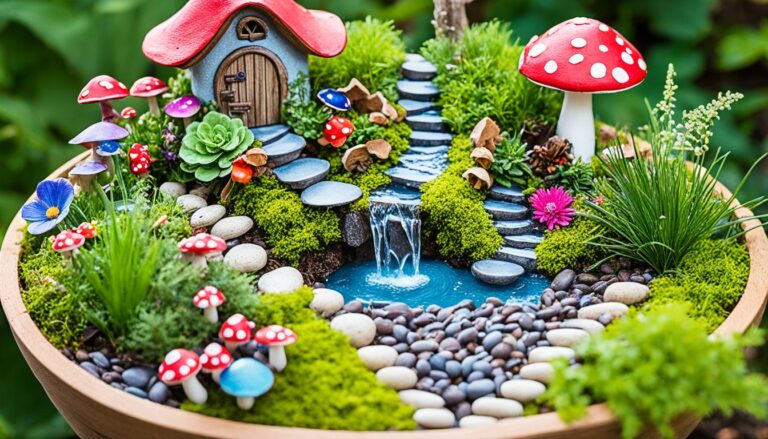Starting a garden can be very rewarding, especially with the best plants for beginner gardeners. Growing veggies, herbs, and flowers not only adds beauty to your home but also connects you with nature. This guide is all about the top simple plants for new gardeners. They are easy to care for and offer great rewards. Whether you have a small space or a big yard, these beginner-friendly plants are a great starting point. We have picked plants that are practical and beautiful, ensuring you get good harvests with low effort.
There are many options for beginner garden plants out there. Picking ones that fit your life and taste is key. As the sun warms your plants, you begin a journey to grow your own food and make your space beautiful. It’s all about turning seeds into something special, making a garden that’s uniquely yours.
Key Takeaways
- Best plants for beginner gardeners Begin with plants that thrive with 6 to 8 hours of direct sunlight to ensure robust growth.
- Start small with a manageable garden size like a 4’ x 4’ raised bed, and gradually expand your gardening space.
- Select from the top 10 easiest vegetables including lettuce, tomatoes, and peppers to gain early gardening success.
- Incorporate staggered plantings in your garden plan for a steady supply of fresh produce.
- Use online garden planning tools to achieve optimal spacing and manage crop rotation efficiently.
- Embrace the beauty of companion planting by adding flowers like marigolds and sunflowers that complement veggies.
Essential Considerations for First-Time Gardening
Starting a garden means more than just planting seeds. There are key choices to make early on. These decisions affect everything, from which plants you choose to how successful your garden is. Learning the basics of gardening can make it as fun and rewarding as it is educational.
Selecting the Ideal Location for Growth
Choosing the right spot is a top tip for beginner gardeners. Most plants, particularly veggies, need 6 to 8 hours of sun. The spot should be shielded from strong winds and have soil that drains well. Meeting these criteria will boost your garden’s health and output.
Understanding Soil Quality and Nutrients
Soil quality is essential for a thriving garden. Nutrient-rich soil supports the growth of strong plants. Adding compost can make the soil even better for roots. This creates a perfect place for plants to grow.
How to Determine the Right Size for Your Garden
For new gardeners, space management is key. Start with a small area, like a 10’ x 10’ plot or a 4’ x 4’ raised bed. This size is not too much for beginners but has enough room for plants to grow. As you learn and get more comfortable, you can try larger areas.
If you’re just starting, consider using an online garden planner like the one from The Old Farmer’s Almanac. It helps with planning by suggesting proper spacing and crop rotation.
Pick veggies that are easy for beginners. Lettuce, tomatoes, and green beans are great first choices. Plant them at different times to enjoy fresh veggies all season long. This will ensure a continuous harvest during the year.
| Vegetable | Season | Recommended Size |
|---|---|---|
| Lettuce | Cool | 4′ x 4′ |
| Tomatoes | Warm | 10′ x 10′ |
| Green Beans | Warm | 4′ x 8′ |
| Peppers | Warm | 12′ x 24′ |
| Kale | Cool | 4′ x 4′ |
Using a beginner’s guide and selecting easy-to-grow plants can make gardening a success from the start.
Best Plants for Beginner Gardeners
Starting to garden is becoming more popular, especially for those looking for easy to grow plants for beginners. It doesn’t matter if you have a green thumb or are new to gardening. It’s good to begin with plants that are beginner-friendly and likely to do well, cheering you on.
If you want to see your efforts bloom into happiness, we have some top picks for you. These plants are tough, need little care, and can handle most places well. They are among the top plants for gardening beginners.
- Peppers: If you like a little heat in your food, try growing jalapeños and Thai chilis. They’re easy to grow and spice up your dishes.
- Mint: Mint is incredibly hardy and grows in many climates. This makes it a must-have for new gardeners.
- Zinnias: Zinnias bring color and attract helpful pollinators. They are easy to care for and provide quick, beautiful blooms.
Adding these beginner-friendly plants to your garden is like setting the stage for success. It keeps you excited about your growing space. For more tips on what to plant and how to plan your garden, click here.
| Plant | Characteristics | Benefits |
|---|---|---|
| Peppers | Easy to cultivate, various types | Enhances culinary dishes, vibrant colors |
| Mint | Resilient, spreads quickly | Medicinal uses, aromatic, requires minimal care |
| Zinnias | Attracts pollinators, easy to grow | Beautifies garden space, diverse colors and sizes |
Choosing easy to grow plants can lead to a garden that’s both beautiful and teaches you a lot. It’s the start of a fun and rewarding path to becoming a better gardener.
Vegetable Gardening Basics for Starters
Starting your first beginner vegetable garden means you’ll soon enjoy fresh veggies from your yard. You might think it’s hard to begin, but it’s not. Follow a clear guide how to start a vegetable garden. It shows you how to grow things like crisp lettuce and juicy tomatoes. Learning the basics will make your gardening fun and fruitful.
Top Easy-to-Grow Vegetables for a Starter Garden
Picking the right veggies is important for new gardeners. That’s why vegetables like radishes, lettuces, and green beans are great picks. They’re easy to grow and need little care. This makes them perfect for those just starting out. Here’s what we recommend:
- Lettuce – Thrives in cooler temperatures and can be harvested early.
- Radishes – Fast growers, perfect for feelings of quick achievement.
- Green Beans – Require minimal upkeep and provide plentiful yields.
- Tomatoes – Popular in home gardens, need staking for support as they grow.
- Zucchini – Offers high yields from each plant.
- Peppers – Adds a variety of colors and flavors to your garden.
Timing Your Planting for Success
Knowing when to plant is key for a good harvest. There are two main types of veggies: cool-season and warm-season. Cool-season plants like spinach and peas should go in the ground in early spring or late summer. Warm-season ones, such as cucumbers and squash, do best when the weather warms up in late spring or summer.
By planting at the right time, you can avoid problems and have a great harvest. This will make your first vegetable garden a big success.
Incorporating Flowers for a Vibrant Garden
For those new to gardening, starting with beginner garden flowers is key. They make the garden look beautiful. They also play a big part in companion planting, creating a lively, all-around better home for plants.
The Role of Marigolds, Sunflowers, and Other Blooms
Marigolds are amazing because they keep pests away. Sunflowers not only look great but they’re also tall. This helps attract important pollinators for vegetable plants. Flowers like black-eyed Susans and lavender bring color and life, making the garden more attractive and diverse.
Companion Planting: Flowers that Support Vegetable Growth
Companion planting uses beginner garden flowers to help vegetable plants grow better. For example, nasturtiums can be grown next to vegetables. They help the soil and keep pests off. Their smell and structure also protect and boost the veggies’ production.
Looking at studies and real gardens, we see how different flowers work:
| Flower Type | Benefits | Companion Plant |
|---|---|---|
| Marigolds | Pest Repellant | Tomatoes, Peppers |
| Sunflowers | Attract pollinators | Cucumbers, Melons |
| Lavender | Scented barrier | Cabbages, Leafy Greens |
| Nasturtiums | Pest control and edible | Squashes, Pumpkins |
Planning and planting strategically is key to great companion planting. It uses the best of both flowers and veggies. This leads to stronger, vibrant gardens.
Plus, these plants are easy to care for. They help new gardeners learn and love gardening. And they make the area more beautiful and lively.
Herbs: A Wise Addition to Any Beginner’s Garden
Starting with an herb garden is both easy and rewarding. Herbs like basil, oregano, and chives spice up your cooking. They also bring a nice smell to your garden, which helps attract helpful insects. These herbs don’t need a lot of space to grow, doing well in small beds or pots.
If you’re looking for easy herbs, there are many choices that will succeed. They are tough and adaptable. This means they are great for new gardeners because they forgive mistakes. Let’s look at some of them:
- Basil: It’s super flexible, easy to grow from seeds, and can keep giving you herbs if you plant more every few weeks.
- Mint and Oregano: These grow fast, so put them in containers to control their spread.
- Chives and Garlic Chives: They spread quickly and need space. Remember to keep picking them to control their growth.
- Parsley: It’s easy and not as fast-spreading as some others. It grows a lot in its first year.
- Cilantro: Great for cool times, it grows fast in spring and can be planted again in late summer for fall harvest.
- Lemon Balm: Smells like lemon and is easier to handle than mint. Perfect for new gardeners.
Learning what your herbs like helps them grow better. Here’s a table with info on popular herbs:
| Herb | Growth Type | Light Requirements | Soil Preference | Watering Needs |
|---|---|---|---|---|
| Basil | Annual | Full sun | Well-drained, slightly acidic | Deep, infrequent |
| Mint | Perennial | Full sun to partial shade | Moist, well-drained | Regular, moderate |
| Oregano | Perennial | Full sun | Well-drained, slightly acidic | Less frequent, deep |
| Chives | Perennial | Full sun to partial shade | Rich, moist | Moderate |
| Cilantro | Annual | Full sun | Well-drained, fertile | Regular, even |
Starting with these herbs will give you a strong garden. Each one brings something special. While they all need care, they are a wise pick for new gardeners wanting to grow their skills and meals.
Best Plants for Beginner Gardeners Recognizing the Proper Planting Times and Techniques
Good gardening begins with right planting times and ways. Using seasonal planting strategies helps plants grow well in nature’s rhythm. This leads to better growth and more produce. The planting guide for beginners ahead gives key advice on how to garden effectively.
Seasonal Guide to Planting: Cool-Season vs. Warm-Season Plants
It’s important to know the difference between cool and warm-season plants for a successful garden. Cool-season plants, like lettuce and peas, do well when it’s colder in early spring or late fall. They can survive light frosts, so planting them early is okay. On the flip side, warm-season plants, including tomatoes and cucumbers, need the soil to be warmer to grow. They should be planted after the last frost in spring. Knowing this means you won’t lose plants to bad weather and your garden stays productive.
Staggering Plantings for Continuous Harvest
Using staggered planting for gardens means you can pick fresh food for longer. This method spreads out when you can harvest, so not everything is ready at once. By planting some crops every few weeks, you can enjoy fresh veggies and fruits for a long time. This also means your garden is more productive and efficient.
Here’s a chart showing the best times and methods to plant common garden plants in Wisconsin. This region is usually in USDA zones 5a and 5b:
| Plant Type | Cool-Season Planting | Warm-Season Planting | Staggered Planting Useful? |
|---|---|---|---|
| Lettuce | Early Spring, Early Fall | N/A | Yes |
| Tomatoes | N/A | After last spring frost | Yes |
| Peas | Early Spring | N/A | Yes |
| Cucumbers | N/A | After last spring frost | Yes |
Using seasonal planting strategies and staggered planting for gardens are key to a hardy garden. With the planting guide for beginners, anyone new to gardening can do well and enjoy a long growing season.
Ensuring Successful Growth with Adequate Care
Starting in the garden involves learning how to care for your plants. This means knowing how much to water them and keeping bugs away with natural methods. Doing this well makes your plants healthy and improves your gardening.
Watering Procedures for Different Plant Types
How you water your plants changes with what kind they are and how old. It’s key to match your watering to what each plant needs. For example, seeds need steady moisture to start, but plants like lavender do better with less water once they’re grown.
It’s best to water early in the day. This stops the water from disappearing too quickly. It also lets the water go deep into the ground where the roots can find it. A good aim is to give plants about 1 inch of water each week. But, change this amount if the weather or soil is different.
Natural Pest Control and Disease Prevention Methods
Keeping the bugs off your plants is critical for new gardeners. Using things like neem oil or soap for bugs can work well without hurting the environment. Also, inviting bugs like ladybugs can help keep the bad bugs in check. This makes your garden healthier overall.
Planting some things together can also stop bugs from ruining your garden. Some plants scare pests away or help their friends grow better. This is a smart way to use your garden space well and keep it healthy.
| Natural Method | Target Pest | Application Frequency |
|---|---|---|
| Neem Oil | Common garden pests | Bi-weekly |
| Insecticidal Soap | Aphids, spider mites | As needed |
| Ladybugs | Aphids, mealybugs | Once per season |
| Praying Mantises | Larger pests | Once per season |
Getting good at gardening starts with the basics. Understand what your plants need and then water and protect them right. More tips are here to help your garden flourish from the start.
Garden Planning Tools and Resources to Get Started
Starting a garden might feel tough for beginners. But, with the right help, even those who think they can’t grow anything can make beautiful gardens. Online garden planning tools and local extension services can make this a lot easier.
Using Online Planning Tools for Garden Layout and Scheduling
If you’re new to gardening, online tools can be a big help. They let you design your garden space and figure out how far apart to plant things. It’s key for your plants to have enough space to grow well. These tools let you see how your garden will look as it grows, change plans easily, and keep track of what to do when. For instance, the Old Farmer’s Almanac Garden Planner adjusts to your local weather, making sure your plants start off right.
Leveraging Local Cooperative Extension Services for Expert Advice
It’s also smart for beginners to check out local extension services. These are in many U.S. states and offer a wealth of advice and information. They can help with how to get your soil ready, dealing with bugs, and what to plant when. This advice is tailored to your local area.
Using these resources early on can make your gardening journey successful. Whether you’re starting a vegetable plot or a flower bed, these tools are here for you. They help you start with confidence, ensuring your plants not only grow but thrive.
Conclusion
Best Plants for Beginner Gardeners Starting a garden is a cool way to go green. You can turn empty spots into thriving mini-ecosystems. Learn to grow plants that are easy for new gardeners.
With care and knowledge, you can welcome tomatoes and marigolds. These plants love sun and water, making your garden a success. This also helps the planet by lowering carbon emissions from food transportation.
Growing your own food is fun. Try producing artichokes and radishes. They cut down on environmental harm from moving food to stores. Gardening is a fun and easy way to help our planet.
You can plant oregano, lettuce, and beans. These plants show you don’t need a big garden to succeed. They teach us big things about caring for nature and our community.














